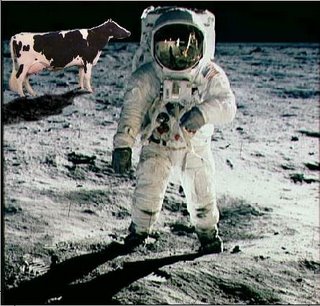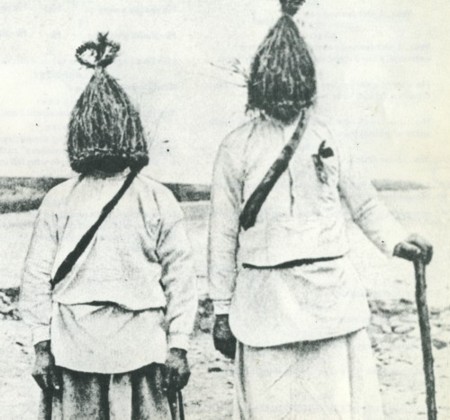
Hello once again from Mbashta, my friends. Today I hear good news from my village: my father's cousin, !Kwi, has a new cow. He tell my father a most strange tale about what this cow have to say about the subject of reverence for the bovine ones. My father, he say to me "Mbashta, my son, you must tell the world about the strange cow that even now is in our paddock. !Kwi's wife, she milk this cow in morning and the cow, she ask her if she intend to slaughter her and eat her all up in a pie or burger or whether she is of the Hindu persuasionskiorum. !Kwi's wife, agog [Note from Mbashta: That's not her name no her name am in fact Ntekkimobiti-Mtekkimobiti], she ask the cow what means hindu, and the cow spake thus:
Hinduism is the world’s oldest religion, more than 8,500 years old. (The Rig Veda mentions a winter solstice in 6,500 BCE, confirming the existence of an advanced civilization much earlier.) Sanskrit is the world’s oldest still-used language.
By 5,000 BCE a sophisticated civilization flourished in India with over 300 settlements in a belt extending 1,520 km. Villages of mud brick houses were being built. The formative phases culminated into a cultural uniformity and single province – the Harappan culture. The Harappan towns by 3,000 BCE were well-planned with citadels and defensive walls. Laid out in grid fashion, the houses had rooms and compartments, with one or two courtyards and a stair leading often to two storeys. In some places 80 feet wide, the streets and lanes had drains, roofed in brick with regular inspection holes. Individual bathrooms and lavatories were impressively drained into a larger system. The amazing thing is that all construction was done with baked bricks which were of a standard size – 24 x 14 x 7 cm – found throughout the Indus valley at this period. The larger cities like Harappa and Mohenjo-Daro probably sheltered 20 to 25,000 inhabitants.
World’s First University
Around 2,700 years ago there existed a giant university at Takshashilã, located in the north-west region of India. Students from as far as Babylonia, Greece, Syria, Arabia and China came to study. 68 different streams of knowledge were on the syllabus. A wide range of subjects, including language, grammar, philosophy, medicine, surgery, politics, astronomy, accounts and music were taught by experienced masters. There were 10,500 students.
Zero
India invented the zero, without which there would be no binary system and no computers. The earliest recorded date, an inscription of zero on sankhedã copper plate, was found in Gujarat, India (585 CE). In Brahmagupta’s Brahma-Phuta-Siddhãnta (seventh century CE) zero is lucidly explained and was rendered into Arabic books around 770 CE. From these it was carried to Europe in the eighth century. However, the concept of zero is referred to as shunya in the early Sanskrit texts of the fourth century BCE and clearly explained in Pingala’s Chandah Sutra of the second century.
Invention of Geometry
The word “geometry” seems to have emerged from the Indian word “gyaamiti”, which means “measuring the earth”. The word “trigonometry” is similar to “trikonamiti”, meaning “measuring triangular forms”. Euclid is credited with the invention of geometry in 300 BCE while the concept of geometry emerged in India in 1,000 BCE, from the practice of making fire altars in square and rectangular shapes. The treatise of Surya Siddhãnta (fourth century CE) describes amazing trigonometric details which were introduced to Europe 1,200 years later in the sixteenth century by Briggs.
The Value of Pi (π) in India
The ratio of the circumference and the diameter of a circle is known as Pi, which gives its value as 3.1415927… The old Sanskrit text Baudhãyana Shulba Sutra of the sixth century BCE mentions this ratio as approximately equal to three. Ãryabhatta in 499 CE worked out the value of Pi to the fourth decimal place as 3.1416. Centuries later, in 825 CE, the Arab mathematician Ibn Musã, said that “This value has been given by the Hindus (Indians).”
Pythagoras’s Theorem or Baudhãyana’s Theorem?
The so-called Pythagoras’s theorem (this theorem by Euclid was attributed to Pythagoras by Greek writers) – ie, that the square of the hypoteneuse of a right-angled triangle equals the sum of the square of the two sides – was worked out earlier by Baudhãyana in Baudhãyana Sulba Sutra (sixth century BCE). He describes: “The area produced by the diagonal of a rectangle is equal to the sum of the area produced by it on two sides.”
100 BCE: The Decimal System Flourishes in India
“It was India that gave us the ingenious method of expressing all numbers by means of ten symbols (decimal system)… a profound and important idea which escaped the genius of Archimedes and Apollonius, two of the greatest men produced by antiquity.” (La Place)
The highest prefix used for raising ten to a power in today’s maths is “D” for 10 to the power of 30 (from Greek “deca”), while as early as 100 BCE Indian mathematicians had exact names for figures up to 10 to the power of 53. In Anuyogdwār Sutra, written in 100 BCE, one numeral is raised as high as 10 to the power of 140.
Astronomy
Indian astronomers have been mapping the skies for 3,500 years.
1,000 Years Before Copernicus
Copernicus published his theory of the revolution of the earth in 1543. A thousand years before him, Ãryabhatta in the fifth century CE stated that the earth revolves round the sun: “Just as a person travelling in a boat feels that the trees on the bank are moving, people on the earth feel that the sun is moving.” In his treatise Ãryabhatteeam, he clearly states that our earth is round, it rotates on its axis, orbits the sun and is suspended in space, and explains that lunar and solar eclipses occur by the interplay of the sun, the moon and the earth.
1,200 Years Before Newton
The law of gravity was known to the ancient Indian astronomer Bhãskarãchãrya. In his Surya Siddhãnta, he notes: “Objects fall on the earth due to a force of attraction by the earth. Therefore the earth, planets, constellations, moon and sun are held in orbit due to this attraction.” It was not until the late seventeenth century, 1,200 years later, that Sir Isaac Newton rediscovered the law of gravity.
Measurement of Time
In Surya Siddhãnta, Bhãskarãchãrya calculates the time taken for the earth to orbit the sun. Between Bhãskarãchãrya’s ancient measurement 1,500 years ago (365.2587 days) and the modern accepted measurement (365.2596 days) the difference is only 0.00085 days – 0.0002%.
Krati = 34,000th of a second…
1 horã = 1 hour
24 horã = 1 divas = 1 day
7 divas = 1 saptãh = 1 week
4 saptãh = 1 mãs = 1 month…
1 kalpa = 4.32 billion years
Surgery
Shushruta, known as the Father of Surgery, practised his skill as early as 600 BCE. He used cheek skin to perform plastic surgery to restore or reshape the nose, ears and lips with incredible results. Modern plastic surgery acknowledges his contributions by calling this method of rhinoplasty “the Indian method”.
“The surgery of the ancient Indians was bold and skilful. A special branch of surgery was devoted to rhinoplasty or operations for improving deformed ears and noses and forming new ones, which European surgeons have now borrowed.” Sir W Hunter (British surgeon 1718 – 1783)
125 Types of Surgical Instruments
“The Hindus (Indians) were so advanced in surgery that their instruments could cut a hair longitudinally.” (Mrs Plunket)
Shushruta worked with 125 kinds of surgical instruments, which included scalpels, lancets, needles, catheters and rectal speculums, mostly conceived after jaws of animals and birds to obtain the necessary grips. He also defined various methods of stitching.
300 Different Operations
Shushruta describes the details of more than 300 operations and 42 surgical processes. In his compendium Shushruta Samhitã he minutely classifies surgery into eight types: extracting solid bodies, excision, incision, probing, scarification, puncturing, evacuating fluids and suturing. The ancient Indians were also the first to perform amputation, caesarean surgery and cranial surgery.
My cousin's wife, by this stage she hiccup and pick her nose with twig, but she decide she too are hindu and she paint a dayglo Om symbol on the roof of our hut."

Well, my friends, what an exciting tale from my father. You see now what an exciting time they have in my home village! If only London was more like my village. I think it is best to be like I am in my village, so when I go to my favourite places like Oxford Street and Piccadilly underground station in your rush hour, I like to greet everyone I see. Sometimes my throat gets a little parched after forty minutes or so, and yesterday the police tried to move me on.


1 Comments:
Swami Darmananda in Rishikesh reckons that aliens would speak Sanskrit because it is a universal language so maybe the Seti people should be transmitting Aums instead of Pis.
Post a Comment
<< Home